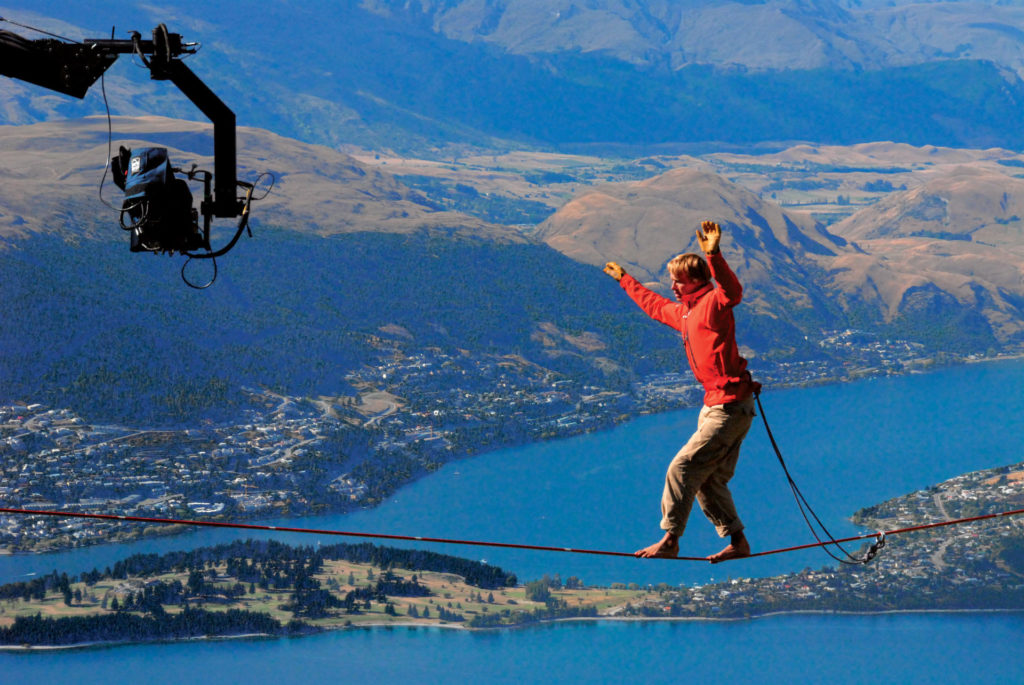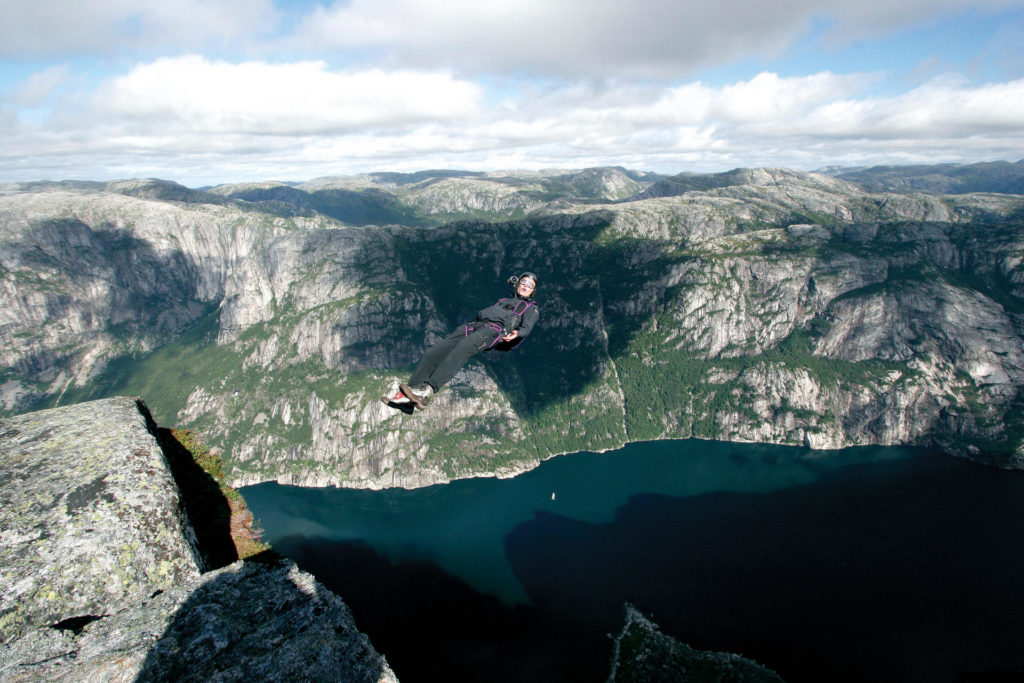Sitting in a popular sushi restaurant in Roppongi, my eyes are watering as I watch my new friend dip a piece of raw fish into enough wasabi to kill an adult water buffalo and then chase it down with a cold beer. Meet Leo Houlding; global adventurer, world-class rock climber, BASE jumper, occasional TV host – and extreme sushi eater.

Amazingly, a few weeks later our paths would cross in Thimpu, the capital of Bhutan. I was tossing the disc (aka Frisbee) with my friend Tim in the town square (where we would soon be mobbed by dozens of local kids) when Leo strolled over from the car park. He had just finished a three-day trek from the Ring of Fire Festival for an adventure travel television show he has been hosting for Virgin 1 TV, a new creation from the Richard Branson empire.
I recently caught up with him again as he finished filming the last segment of the six-part series.
Gardner Robinson (GR): Was this your first gig as a TV presenter?
Leo Houlding (LH): Yeah, it was hard to begin with….but fun…we’ll see how it turns out, but TV is a fun industry. We did six adventure shows in just over three months. The adventures had a tribal, cross-cultural theme where we’d live the day-to-day life with locals and then take them on an adventure. In Kenya we hung out with four Maasai warriors.

GR: So it was a cultural and adventure experience?
LH: Yeah, I killed a cow – stabbed it through the spine with a knife and then drank blood out of its heart while it was dying. After that we took the Maasai warriors rock climbing and slack-lining. It was a blast, they loved it.
Sounds like the Maasai warriors got the better end of that deal…you said the show ended on a high note in Oman?
Yeah, the final scene was a BASE jump into the Cave of the Genies in Oman. The mouth of the entrance is just 40 feet across. It was really dark, and you can’t open your chute for a couple of seconds, so it’s pretty scary, but then the tunnel opens into a cathedral-like cave. We abseiled in first to check it out, but BASE jumping with your bros is different than when there’s the pressure of the production crew there. It was a good end to the show.
GR: So what got you into climbing in the first place?
LH: I’m from the Lake District (in northern England), the birthplace of modern rock climbing. The area’s climbing roots go back to the 1850s in the days of aristocratic alpine climbing. My father was into hill walking, and he had a friend who was a rock climber, so I came from a traditional mountain background. I started hill walking, then scrambling up the mountains and naturally rock climbing.
GR: Has the climbing scene in the U.K. changed much?
LH: Indoor climbing changed things a lot. There is a higher standard of climbing, but not as much old-school dedication, sleeping under rocks, partying all night. Bouldering has gotten huge. There are a lot of climbers nowadays who don’t even own rope.
GR: Were there any climbers who especially inspired you?
LH: I admire the spirit of British climbers from back in the ‘70s such as Alex McIntyre and Al Rouse; they not only were awesome climbers but were also the last guys standing at the party. Yuji Hirayama has been an inspiration as well. He’s by far the most famous Japanese climber on the international scene and has been world champion a couple times (1998 and 2000). He does a lot of onsight climbing—doing a route on first sight without inspecting it or seeing anyone climb it.
GR: The climbing community recently lost Sir Edmund Hillary. Did he influence you much as a climber?
LH: I met him in Banff a few years ago. I’m actually more impressed with what he did after he climbed Everest. He was a real humanitarian. The people of the Kumbu really affected his life; he devoted a lot of time setting up schools and helping the Sherpa people.
I think what’s so impressive about his climbing accomplishment was the lack of information available at the time. These days, nearly any fit, well-acclimatized person with an experienced guiding company has a pretty good chance of reaching the summit. But back in the day, they didn’t know how the altitude would affect them; they were really going into unknown territory.

GR: In June, 2007, you reached the summit of Mt. Everest. Did the climb live up to your expectations?
LH: When I was a kid I had a teacher, Mrs. Bird, who was into the history of Everest, the disappearance of (George) Mallory and (Andrew) Irvine and so on. I was seduced by the stories and really wanted to climb it. Once I became aware of the modern day circus that surrounds the mountain I lost some interest, but when I got an offer to climb it for free as part of the Altitude Everest Expedition, it was hard to say no. All that childhood inspiration came back.
We shot a movie called “The Wildest Dream” using 1920’s equipment up to 7,500 meters. It will be in cinemas worldwide this summer. Must say thanks to Conrad Anker, expedition leader, Russell Brice of Himalayan Experience who took care of the logistics of filming on Everest and to Ang Furbar and his incredible Sherpa team for making the dream a reality.
I have to admit, climbing on the North side on summit day was one of the most breathtaking climbs with amazing views, exposed terrain…I spent a full 10 minutes alone on the summit. We were so late in the season, there was nobody else on the mountain. My father-in-law died just before the trip. He was a climber for 50 years and I took a photo of him with me to the top. It was beautiful weather, warm by Everest standards; I had a tranquil 10 minutes of contemplation up there. It was so peaceful, I almost forgot I was chillin’ in the Death Zone, so I got up and started down.
Is there any specific climbing achievement you are most proud of?
Yosemite is my favorite place to climb in the world. I climbed El Nino – a 3,000-foot route on “El Cap” and only fell once in 33 pitches of really hard climbing. No one has made it without falling…and I think only one other person has fallen twice, Yuji (Hirayama) came close in 2004.
GR: So how did you get into base jumping and slack lining?
LH: My favorite style of climbing is free climbing on the world’s largest cliffs. When you’re up there and realize how much effort it is to go back down—it can take days sometimes—two or three minutes if freefall looks pretty good. So it seemed like a natural progression from big wall climbing to base jumping.
Not coincidentally, the best places for big wall climbing are often best for jumping. I remember the first time I was on the rock and heard a cracking noise overhead, tensed up and waited for some rock to fall, then this guy came screaming past me down the wall; it was in Norway in 1999…I got myself trained up and did my first jump near Sacramento, California, in 2003. There’s even a term for it now, “para-alpinism.” Slack lining basically started out as a rest day activity in Yosemite. You can pretty much trace it back to a bunch of us doing it there 1998, and then it was everywhere. High lining was just an extension of that. It’s surprising how popular it has become. Some slack liners don’t even climb.
I sometimes hear people say base jumping can be quite safe, but most people I talk to have lost close friends to jumping.

GR: What are your thoughts on the perception and reality of the sport?
LH: It actually can be extremely safe if people take the right precautions, stay in your comfort zone and jump in safe areas, be aware of the terrain and weather and pull your chord high. But the nature of base jumping as an extreme sport attracts the kind of people who want to push the envelope. They are generally not the kind of people who like to play it safe, which can lead to elevated risk.

Some accidents also happen because people are jumping who in reality don’t have the experience or skills. It’s just like extreme skiing or big wave surfing; you really need to know what you are doing and, if you don’t, you can get killed.
Urban jumping and illegal jumping in U.S. national parks has given base jumping a bad rap. Recently in France, there has actually been a movement to recognize BASE jumping as a legitimate mountain sport and improve safety. You can even get insurance for base jumping there now.
I saw a YouTube clip of some guys wearing bird-like suits seriously hauling ass along some cliffs without a chute open…what is that all about!?!?
They’re wearing wingsuits. I actually just ordered one. Wingsuit flyers started out using these special suits to fly away from the jump spot, but now they are doing “proximity flying” where they actually stay in close to the cliffs, not away. It’s scary as hell, and you gotta be good at it. It’s the closest to flying a fighter jet without having to kill anyone. You can hit speeds of 200 mph ground speed.
GR: Between your busy adventure, promotional and now TV activities, what keeps you motivated?
LH: I’ve been a full-time climber for 10 years, and I’ve had the privilege to be part of a community of people constantly pushing the limits of what’s possible. The standards keep getting reset, and it’s inspiring to be part of that group. Even outside of rock climbing, adventure has been a main focus of my life, and it’s been a very rewarding and positive thing. I think most people would get more out of life if they had more adventure in it.
GR: You were recently in Japan for the launch of Berghaus Japan. How did you get hooked up with them?
LH: I’ve been sponsored by Berghaus for 10 years now. They are based not far from where I grew up and we began working together in 1997.They’re constantly developing new kit (gear) and they’ve been really good to me. I had a serious accident in 2002; they really stood by me, even before knowing if I’d fully recover. Not many sponsors would do that and I think it says a lot about the company. Their tagline used to be, “trust is earned” and I took that to heart.
GR: Are you looking forward to coming back to Japan?
LH: I’m super-stoked to get back to Japan and climb. I’d love to come in fall and see all the maple leaves changing. I’d love to climb with Yuji, and it would be fun to check out some of the local crags. My favorite kind of climbing is deep water soloing. You traverse in or start from a boat, and you can climb safely up to 20 meters and then launch into the water. It’s a really free, unencumbered way to climb. It would be fun to find some spots to do that in Japan. And I love the food.





